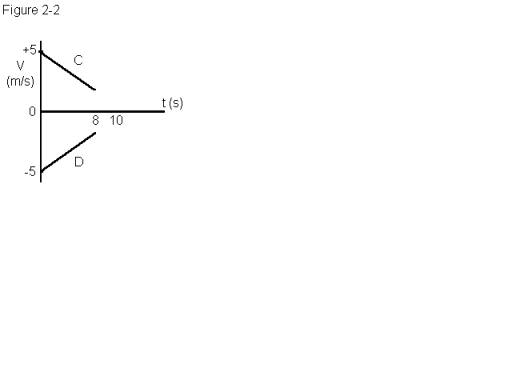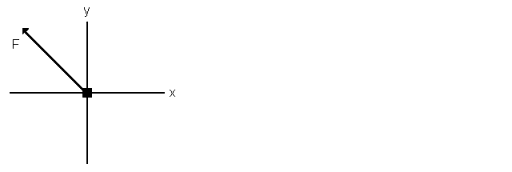
A. Kinematics Qualitative Quiz
Each Question is worth 7.5 points (total possible: 300 points)
Instructions:
∑
You
may use your book and/or notes
∑
You
should try to NOT use a calculator since you will not be allowed to use one on
the actual AP examination.
∑
Make
an answer sheet with numbers 1-40 on it and write the letter answers on it. Turn
it in to me on the due date
∑
No
need to print this out since it will be available to you on the internet for the
entire length of the course.
∑
I
put in some hints: in places.
I hope you find them helpful
GOOD LUCK!!!!!!!
1.
Which of the following can never be negative?
a. Average velocity
b. Displacement
c. Instantaneous speed
d. Acceleration of gravity
2.
If you run a complete loop around an outdoor track (400 m), in 100 s,
your average velocity is
a. 0.25 m/s
b. 4.0 m/s
c. 40,000 m/s
d. zero
3.
If you run a complete loop around an outdoor track (400.m), in 100/s,
your average speed is:
a. 4.0 mph
b. 4.0 m/s
c. 4.0 km/h
d. 40000. m/s
4.
All of the following are scalars, except:
a. mass.
b. force.
c. temperature.
d. distance.
5.
All of the following are vectors, except:
a. density
b. force
c. displacement
d. velocity
6.
It is possible to have constant speed, but still be accelerating.
a. True
b. False
7.
It is possible to have a zero acceleration, and still be moving.
a. True
b. False
8.
When is the average velocity of an object equal to the instantaneous
velocity?
a. This is always true.
b. This is never true.
c. This is the case only when the
velocity is constant.
d. This is the case only when the
velocity is increasing at a constant rate.
9.
Refer to Figure 2-1, At t = 0 s
a. rider C is ahead of rider D.
b. rider D is ahead of rider C.
c. riders C and D are at the same
position.

10.
Again Refer to Figure 2-1 (above), At t = 0 s
a. C has a greater velocity than D.
b. D has a greater velocity than C.
c. C and D have the same velocity.
d. C is accelerating.
11.
Again Refer to Figure 2-1 (above), At t = 10 s
a. C and D are at the same position.
b. C and D have the same velocity.
c. the velocity of D is greater than
the velocity of C.
d. C is in front of D.
12.
Refer to Figure 2-2 (below this question), During the first 8 s
a. C is slowing down, and D is
speeding up.
b. C and D are both slowing down.
c. C and D have constant velocities.
d. C has the same average velocity as D.
13.
Refer to Figure 2-2 (below this question), During the first 8 s
a. C always has a greater
acceleration than D.
b. D always has a greater
acceleration than C.
c. their accelerations are equal in
magnitude, but opposite in sign.
d. their accelerations are equal in magnitude, and equal in sign.
14.
Refer to Figure 2-2 (below this question), Based on all the graphical
information
a. they meet at the same position at
t = 8 s.
b. they will meet at the same
position at t = 10 s.
c. they will never meet at the same
position.
d. not enough information is given
to decide if they meet

15.
A negative velocity, approaching zero represents a negative acceleration.
a. True
b. False
16.
Can an object's velocity change direction when its acceleration is
constant?
a. No, this is not possible because
it is always speeding up.
b. No, this is not possible because
it is always speeding up or always slowing down, but it can never turn around.
c. Yes, this is possible, and a rock
thrown straight up is an example.
d. Yes, this is possible, and a car
that starts from rest, speeds up, slows to a stop, and then backs up is an
example.
17.
A can, after having been given a kick, moves up along a smooth hill of
ice. It will:
a. travel at constant velocity.
b. have a constant acceleration up
the hill, but a different constant acceleration when it comes back down the
hill.
c. have the same acceleration, both
up the hill and down the hill.
d. have a varying acceleration along
the hill.
18.
When a ball is thrown straight up, which of the following is zero at its
highest point?
a. displacement
b. velocity
c. acceleration
19.
When a ball is thrown straight up, the acceleration
at its highest point is:
a. upward
b. downward
c. zero
d. horizontal
20.
A skydiver jumps from a high-flying plane.
When she reaches terminal velocity, her acceleration
a. is essentially zero.
b. is in the upward direction.
c. is approximately 9.8 m/s2
downward.
21.
A skydiver jumps from a high-flying plane.
When she reaches terminal velocity, her velocity:
a. is essentially zero
b. is decreasing
c. is essentially constant
22.
Which of the following speeds is greatest? (Hint:
You might want a calculator for this one, but you should memorize which
is the greatest speed for future reference)
a. 10 km/h
b. 10 mi/h
c. 10 m/s
d. 10 ft/s
23.
For this problem, assume that the acceleration of gravity is 10 m/s2
downward, and that all friction effects can be neglected.
A ball is thrown upward at a velocity of 20 m/s.
What is its velocity after 3 s?
a. 10 m/s upward
b. 10 m/s downward
c. zero
d. none of the above choices is
correct
24.
Which of the following is an accurate statement?
a. A vector cannot have zero
magnitude if one of its components is not zero.
b. The magnitude of a vector can be
less than the magnitude of one of its components.
c. If the magnitude of vector A is
less than the magnitude of vector B, then the x-component of A is less than the
x-component of B.
d. The magnitude of a vector can be
positive or negative.
25.
If you drive west at 20 mi/h, then drive east at 15 mi/h, your average
velocity will be:
a. 5 mi/h east.
b. 35 mi/h west.
c. 35 mi/h east.
d. 5 mi/h west.
e. cannot be determined;
insufficient information.
26.
If the acceleration vector of an object is directed anti-parallel to the
velocity vector,
a. the object is turning.
b. the object is speeding up.
c. the object is slowing down.
d. the object is moving in the
negative x-direction.
27.
Two displacement vectors have magnitudes of 5 m and 7 m, respectively.
When these two vectors are added, the magnitude of the sum
(Hint:
You havenít been given a direction for either vector)
a. is 12 m.
b. could be as small as 2 m, or as
large as 12 m.
c. is 2 m.
d. is larger than 12 m.
28.
If the acceleration of an object is always directed perpendicular to its
velocity, (Hint:
remember what happens when you kick a ball perpendicular to its motion)
a. the object is speeding up.
b. the object is slowing down.
c. the object is turning.
d. this situation would not be
physically possible.

29.
200-lb force is pulling on an object, as shown.
The sign of the x and y components of the
force are
a. x
(positive), y (positive).
b. x
(positive), y (negative).
c. x
(negative), y (positive).
d. x
(negative), y (negative).
30.
If you want to cross a river in a motorboat in the least amount of time,
(least time in water) you should head
a. straight across the river.
b. slightly upstream.
c. slightly downstream.
d. the time will be independent of
how you head your boat.
31.
Bullet G is dropped, from rest, at the same time that another bullet H is
fired horizontally from a rifle. If
both bullets leave from the same height above the ground, then... (this is
perhaps the most important concept in physics. You really need to make
sure you get this one correct!)
a. bullet G hits the ground before
bullet H does.
b. both bullets hit the ground at
the same time.
c. bullet H hits the ground before
bullet G does.
d. not enough information is given
to compare when they hit.
32.
A girl throws a rock horizontally, with a velocity of 10 m/s, from a
bridge. It falls 20 m to the water
below. How far does the rock travel
horizontally before striking the water? (Use
g = 10 m/s2) (HINT: Realize that if she throws
it completely horizontally, it will take the same time to hit the water as if
she just dropped it straight down. This is another fundamental problem of
projectile physics and I wouldn't be surprised if it ends up on next week's in
class quiz as well.........)
a. 14 m
b. 16 m
c. 20 m
d. 24 m
33.
An arrow is shot, from a bow, at an original speed of vo.
When it returns to the same horizontal level,
its speed will be
a. 1/2 vo
b. vo
c. 2 vo
d. 9.8 vo
34.
The acceleration of gravity on the moon is only one-sixth of that on
earth. If you hit a baseball on the
moon with the same effort (and at the speed and angle) that you would on earth,
the ball would land
a. the same distance away.
b. one-sixth as far.
c. 6 times as far.
d. 36 times as far.
35.
You toss a ball to a friend. When
the ball reaches its maximum altitude, its acceleration:
a. is zero
b. changes sign
c. is constant
36.
You hit a tennis ball over the net.
When the ball reaches its maximum height, its speed is
(Hint: Remember that
speed refers to both x and y components unless otherwise specified.
Yes, itís true that Vy is zero at the top, but what about Vx?)
a. zero.
b. less than its initial speed.
c. equal to its initial speed.
d. greater than its initial speed.
37.
You are serving the volleyball for the second time in a volleyball game.
If the ball leaves your hand with twice the velocity it had on your first
serve, its horizontal range R (compared to your first serve) would be (Hint:
Remember the range equation and that Vo is SQUARED!)
a.
![]() times as much.
times as much.
b.
half as much.
c.
twice as much.
d.
four times as much.
38.
A stone is thrown horizontally from the top of a tower at the same
instant that a ball is dropped vertically.
Which object is traveling faster when it hits the level ground below?
(Hint:
The stone will hit the ground with both an x and a y velocity
component while the ball will hit with only a y component)
a. It is impossible to tell from the
information given.
b. The stone
c. The ball
d. Neither, since both are traveling
at the same speed.
39.
An Olympic athlete throws a javelin at four different angles above the
horizontal, each with the same speed: 30 o 40 o
60 o
80 o.
Which two throws cause the javelin to land the same distance away?
a. 30 o and 80 o
b. 40 o and 60 o
c. 40 o and 80 o
d. 30 o and 60 o
40.
When air resistance is a factor, maximum range is achieved when the
projection angle is:
a. less than 45. o
b. 45. o
c. greater than 45. o